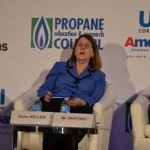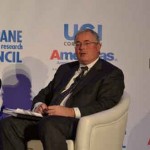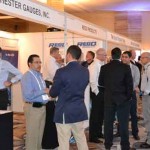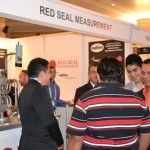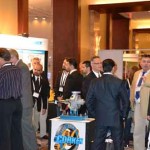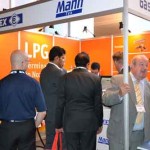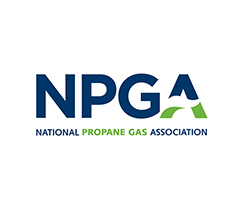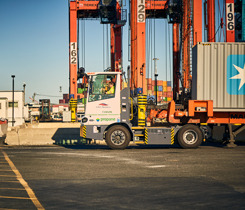LP Gas magazine reporting daily from World LP Gas Forum
Technology conference, autogas summit cap forum
The final day of the World LP Gas Forum featured a technology conference that covered a range of innovations. Sessions covered product developments for propane operations, as well as propane applications that can grow gallons across the world.
U.S. representatives who spoke at the conference were Neil Leslie, Gas Technology Institute; Shelby Ahmann, TouchStar Group; Anne Feudner, Kohler Power Systems; Mark Walls, Southwest Research Institute; and Chris Dockery, Yanmar America.
An autogas summit followed the technology conference. Roush CleanTech‘s Joe Thompson, Stennis Institute‘s Dallas Breen and ThyssenKrupp‘s Tom Armstrong delivered presentations at the summit.
For full coverage of the World LP Gas Forum, see the December issue of LP Gas magazine.
Panelists: U.S. role in propane’s global price to expand
ICF International’s Mike Sloan and Wood Mackenzie‘s Anne Keller were two of six speakers Wednesday to participate in a World LP Gas Forum roundtable that explored propane pricing. The roundtable conversation focused largely on propane production in the United States and its impact on pricing around the world.
“We expect to see continued rapid growth of propane supply in the United States,” said Sloan, ICF principal. “Right now there is an excess of propane production around the Mont Belvieu, (Texas), area. When the export facilities come online and start feeding into the international markets, that should help bring down overall prices in international markets relative to where they would have been without that.”
Sloan added that he expects the price at Mont Belvieu to be a tremendous driver of global propane prices over the next decade.
“I do think the Mont Belvieu price will become more important over time,” Sloan said. “It will have a bigger influence on other market prices. That’s to be expected as the role of the U.S. export market becomes more important internationally. Is there going to be one price [globally]? No. But the U.S. price will be important.
“We’re living in very exciting times,” Sloan added. “There are big changes in the market that we’re all adapting to. But we can expect changes going forward that we don’t [currently] see that will have a big impact on the market over the next 10 to 15 years.”
Keller shared a number of Sloan’s viewpoints, pointing out that multiple factors will influence propane prices in the coming years. Storage is one driving factor she discussed.
“We simply don’t have enough space [in the U.S.],” said Keller, an NGL research manager at Wood Mackenzie. “We don’t have the ability to move the brine that supports our 200-plus million barrels of capacity. The storage limiter here is the ability to move the water in and out of the caverns to push the material around. That has expanded some, but the question is [will that be established] quickly enough?”
Mark Plyte, another roundtable panelist who is the financial director at United Kingdom-based Flogas Group, said recent price volatility has been a tremendous industry challenge.
“Look at the last 12 months,” Plyte said. “We’ve seen the market move and jump 17 percent in a four-week period – from one month to the next. You’ve also seen it fall 16 percent in the last several weeks.”
Price volatility not only affects propane retail companies, but it has an effect on propane consumers, Plyte added.
Game changers
Notable changes and major projects taking place in the LP gas industry were outlined during the forum.
An export terminal in development on the West Coast for producers to access Asian markets, as well as the expansion of the Panama Canal to aid shipping traffic will continue to link LP gas markets, according to information in one of Wednesday’s educational seminars.
When the project is complete in 2017, Sage Midstream, in partnership with Haven Energy, will have the ability to ship 47,000 barrels of LP gas per day from the Port of Longview, Wash., said John Steen, vice president of business development for Sage.
The success of West Coast exports will be dependent on the amount of supply moving to the new location via rail, he added.
The Panama Canal expansion, to accommodate all sizes of very large gas carriers, involves the deepening and widening of the Pacific and Atlantic entrances and the building of locks. The expanded canal is on track to open in the first quarter of 2016.
“The Panama Canal will become one of the key elements in terms of the value chain for LPG and other gases from the shale revolution going to different markets, mostly in Asia,” said Jose Ramon Arango of the Panama Canal Authority.
WLPGA website launch
World LP Gas Association leaders launched a new website (http://lpg-apps.org) that it hopes will grow awareness of the fuel. The site allows users to search by market sector, function and keywords. Propane Education & Research Council (PERC) President and CEO Roy Willis was part of an elaborate launch in which leaders rang a bell and showed a dramatic video of what the site can do.
Greengear Global
Cavagna is an Italian manufacturer of gas control products, but it’s also known for a wide variety of propane-fueled OEM equipment offerings, including lawn mowers, generators, pressure washers and more. And it’s taking that part of its business to another level with Greengear Global Ltd. Cavagna says the new company’s goal is to deal with the manufacturing, marketing and promotion of Greengear products around the world. Cavagna also showed a video (found at www.greengearglobal.com) during a forum presentation, highlighting its propane power equipment. “We like to find new ways to approach and improve the market,” said Giorgio Basaglia, who presented at the forum.
Women in Propane
The NPGA’s Women in Propane Council took its leadership messages to the world stage. After holding a session in which it talked about its initiatives in the United States, a panel of leaders from around the world gathered to talk about the global outlook for women in the propane industry.
Smart-Hose demos breakaway safety system
Smart-Hose Technologies hosted a live pull-away demonstration of its breakaway safety system at an offsite event. Smart Hose demonstrated a breakaway with 90-degree and 45-degree hose ports, exhibiting the simplicity of the system in which valves close just before a breakaway occurs. Watch a video of the demo on LP Gas’ YouTube channel.
“What Smart-Hose did a few years ago is engineered a breakpoint,” said Tim Raftery, Smart-Hose’s vice president of sales, marketing and special projects. “Basically, the hose fitting is in two pieces, and it gets gripped together with the breakpoint.
“If you catch ahold of that, what would happen is the ring would separate. The valves would close; the ring would separate. We could be closed at the bulkhead side; we could be closed at the other side. You’re going to lose what’s in the hose, but you’re not going to take a chance of having an uncontrolled release. That’s the Smart-Hose system.”
According to Raftery, the Smart-Hose system achieves a full-flow breakaway and the system never needs to be rebuilt.
“The system is proactive,” he said. “It’s not reactive. When you start talking about safety, it doesn’t get any better than being proactive.”
World LP Gas Forum Photo Album
- Photos: LP Gas Magazine
- Photos: LP Gas Magazine
- Photos: LP Gas Magazine
- Photos: LP Gas Magazine
- Photos: LP Gas Magazine
- Photos: LP Gas Magazine
- Photos: LP Gas Magazine
- Photos: LP Gas Magazine
- Photos: LP Gas Magazine
AmeriGas parent company CEO offers perspective on U.S. supply
John L. Walsh, CEO of AmeriGas‘ parent company, UGI Corp., offered some perspective on the challenges facing the U.S. propane industry at a World LP Gas Forum roundtable discussion. One of Walsh’s biggest concerns is that propane infrastructure across the country is not yet on par with the increased demand for the product.
“There’s a tremendous need for infrastructure across the U.S.,” Walsh said. “You see a lot of disruption caused by a lack of infrastructure, both in the LPG business and in the natural gas sector. One challenge ahead is to build a lot of infrastructure, and to do that consistently and effectively.
“There is not traditional NGL infrastructure in the Marcellus [Shale] because it’s only become a significant resource in the last five to seven years,” he added. “So now you see a significant focus on accelerating investments in additional storage, additional railcars. There is significant fractionation under way in other places, so it’s really about storing and moving products. Frankly, [the change] is going to take a number of years.”
Another challenging facing the propane industry – here and around the world – is the development of petrochemical demand, Walsh said.
“The other issue is the uncertainty of chemical demand,” he said. “Core residential demand and commercial demand is one thing – it’s pretty easy to predict. The chemical demand is quite volatile. As a marketer and a distributor, you’re concerned about price volatility.”
Still, Walsh said he’s optimistic about propane supply in both the mid and long term – even despite the challenges the industry faced last winter.
“What last winter taught us is you have to have a diverse set of resources,” he said. “Fortunately for us, we were able to move product from other parts of the U.S. that weren’t impacted by weather. Last winter stressed the need for significant investments in the [affected] region.”
Globalization, exports topical at keynote event
A series of speakers kicked off a segment of the World LP Gas Forum, including Kimball Chen, co-chairman and CEO of Energy Transportation Group, and Jonathan Saul Benchimol, president of AIGLP and superintendent director of Brazil-based Fogas. Chen briefly discussed the globalization of the propane industry, arguing that the industry is very much connected to various events that occur each day throughout the world.
“We are increasingly tied together by globalization – the trends in technology, trends in civic issues, trends in supply and demand,” Chen said. “Even though you may only operate in your home country, things happening in other countries affect what you do in your country.”
Benchimol spoke after Chen and made a few remarks about the changing supply scene in the United States.
“The U.S., not long ago, was a major LP gas importer,” Benchimol said. “Today, the USA is the largest exporter of LPG in the world. According to estimates, the U.S. will export roughly 15 million metric tons [this year]. That’s [about] twice the consumption of Brazil, which is one of the top-10 consuming countries of LPG in the world.”
Jack Osterholt, deputy mayor of Miami-Dade County, and Rosanety Barrios, policy coordinator of industrial transformation of hydrocarbons for Mexico, also spoke. Osterholt welcomed forum delegates to Miami, while Barrios, the event’s keynote speaker, discussed the energy reform taking place in Mexico – including developments with LP gas.
Kickoff
On the eve of the World LP Gas Forum, a welcome reception was held at the InterContinental Miami, host venue for the 27th annual event. Attendees mingled on the trade show floor. Members of the National Propane Gas Association, which held its fall meetings in conjunction with the world forum, were among those in the crowd.
PERC presence
PERC made its presence known during the world forum, hosting roundtable discussions covering a number of market segments in which propane can play a key role.
PERC leaders and OEM partners offered insight into on-road fleets, the off-road and commercial landscaping markets, agriculture and a combination of the residential, commercial, construction and rental markets.
OEMs showcased equipment, including an autogas dispenser, engines, generators, lawn mowers and a tankless water heater.
PERC President and CEO Roy Willis was also part of a forum session that detailed efforts in the United States to create year-round demand for propane.
CleanFuel USA announcement
CleanFuel USA, exhibiting at the world forum, announced the addition of mass flow meter technology to its line of propane autogas refueling dispensers.
Global demand is high for mass flow technology, and CleanFuel USA is offering availability for the first time in the United States and worldwide, the company said.
Sourced by Endress+Hauser, the mass flow meter is available in all CleanFuel USA refueling dispensers, including the P2000, 6000 and 7000 series. CleanFuel USA is displaying the P7000 and 2000 series dispensers with mass flow meter technology at the show, in addition to its eConnect, a fuel network management system for electronic dispensers.
Coverage plans
Propane industry stakeholders from around the globe will gather Oct. 28-30 in Miami for the 27th World LP Gas Forum. It is the World LP Gas Association’s first world forum in the United States since Chicago hosted in 2006. The annual event will feature a trade show, educational sessions and roundtable discussions about the worldwide use of propane. A Global Technology Conference and Global Autogas Summit will follow the show. LP Gas magazine will report daily from the show with news and notes that will appear on the lpgasmagazine.com homepage. Follow our editors on social media at twitter.com/lpgas_mag and facebook.com/lpgasmagazine.
Photos: LP Gas Magazine









